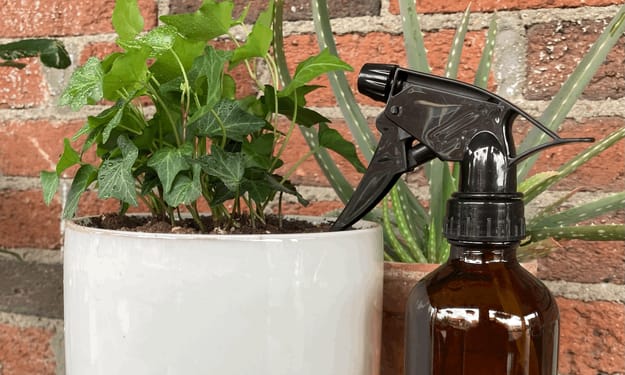How to Rescue a Clearance Phalaenopsis Orchid
A Thrifty Guide

So you're out and about and see the exceptionally large clearance section of overly-watered or neglected plants (I tend to see this at Lowe's or Home Depot), and they're marked half off because they're "rehab" plants. Fine by me, I will nurse that amazing phalaenopsis orchid back to health, and for half the cost too.
PS - Don't expect flowers on a rehab orchid at purchase. Someday we'll talk about how to get them to re-flower, but let's get the orchid back in good shape first.
You will need:
- A rehab orchid
- Water (I write this because sometimes this matters. Fortunately, where I live, my plants have never had an issue with our city tap water. However, some people have had issues with chlorine. If that's the case, I recommend spring water or allowing tap water to sit out in a jug for a day or two so the chlorine evaporates.)
- A bowl to soak the orchid in
- Sharp scissors or pruners
- Hydrogen Peroxide
- New potting mix (such as orchid bark or sphagnum moss)
- Recommeded: a pot specifically made for orchids, or a wall mount (which allows for a lot of air flow)
Depending on how they were cared for, you'll have one of two issues with a rehab orchid: root rot from overwatering, or shriveled roots from neglect. Roots are an essential, foundational tissue to any plant (minus a few weird species) - as they absorb water and nutrients. (How would you fare without a nose or mouth?)
Root Rot
Diagnosis
Let's discuss the root rot first, as I see this the most frequently in my local area. This occurs because the orchids were left sitting in water for too long. Once you get the orchid home, remove it from it's pot(s). There are usually two - the decorative one, and the plastic liner. Remove the old media (likely sphagnum moss). If there is root rot, the roots will appear brown or black, and feel mushy to the touch. Healthy roots should look white to green in color, and be relatively firm.
Treatment
Take your sharp scissors, and begin to cut off the worst of the rotted roots. As a rule of thumb, I try to never cut more than 50% of the roots off. If the root rot is covering more than 50%, than do NOT cut more than 50% of the roots off. Just cut the worst of them, and hopefully the hydrogen perxide will help out with the rest. Fortunately, I rarely see this. If you see spots of rot, cut them out and leave as much healthy root length as possible. You frequently don't need to cut the whole length of the root off to remove the rot.
After surgery, I would soak the plant in a 50%-75% hydrogen perxide solution (50%-25% being water) for 5 minutes. This part is super fun because there is a lot of bubbly noises - I like the satisfaction of being able to hear the chemical reactions. After soaking, gently rinse off the orchid in normal water and re-pot in a pot or mount that allows a lot of air-flow. I generally recommend orchid bark, but especially so when dealing with root rot. (Unless you are using a wall mount, then pair it with moss.)
*A note on sphagnum moss: sphagnum moss is going to hold onto water for longer than bark will, which is what makes it GREAT media for propagating orchids. In addition, sphagnum moss has great nutrients readily available to orchids. However, outside of propagation, I personally prefer orchid bark.
Shriveled Roots
Diagnosis
The other problem I see less frequently is shriveled roots from under-watering. Once you get the orchid home, remove it from it's two pots (decorative and liner). Remove all of the media, and you will see pale white to cream colored roots that are shriveled. Sometimes, they will have a tough string looking tissues in the middle. Healthy roots should be green to white in color.
Treatment
Soak the orchid in water (the orchid should be bare-root, in a container with water that reaches to the base of the orchid - all roots are submerged in water). Start with an hour and check the consistency of the roots. You will know they have been soaking long enough when they return to a healthy color and are firm. Increase the time of soaking if they are not yet firm. Last time I treated an orchid with this issue, I accidentally let it soak for over a day in water and it turned out fine - so don't worry too much about over-soaking.
Once the roots are firm, re-pot in an orchid pot or mount that allows a lot of air-flow. I generally recommend orchid bark as a medium in pots, and moss on mounts.
Follow Up
With either type of issue, after re-potting, you will not need to do anything for three weeks. After that, I would return to a care routine. With Phalaenopsis orchids, I typically soak them in water for an hour (pot and all) once every three weeks. The fertilizer I am currently using recommends a mist once a week with their fertilizer sprayer, so I do that as well (but this is separate from watering).
Rescue orchids are so fun! For one, they're a lot cheaper and have the capacity to re-bloom. Additionally, it is really rewarding to see the before and after of the roots even with 10 minutes of treatment. This is especially true months later when you see new leaves developing or a new orchid spike from the once very sad plant. I have done this with many orchids and seen a lot of success!
In addition, any skill has a learning curve - seeing what works and what doesn't. Don't be disheartened if your orchid, or other plant for that matter, struggles. You are better off for trying and gaining experience.
About the Creator
Courtney Nugen
Hi! I am Courtney Nugen. I breathe plants and books, and dabble in writing. I graduated from the Ohio State University with a bachelor in science for agroecology and a minor in Spanish.






Comments
There are no comments for this story
Be the first to respond and start the conversation.